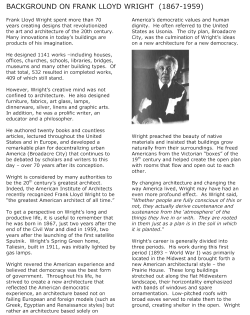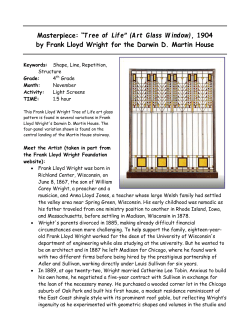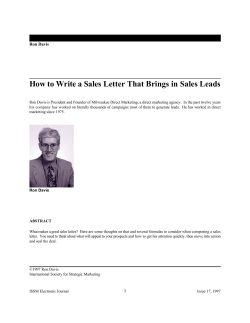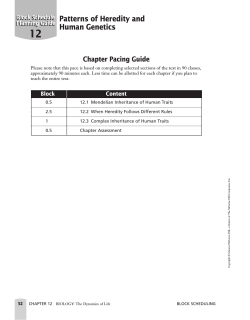
Addition/Subtraction Facts Table 6 1
Name LESSON 61 Copyright © Wright Group/McGraw-Hill 䉬 Date Addition/Subtraction Facts Table , 0 1 2 3 4 5 6 7 8 9 0 0 1 2 3 4 5 6 7 8 9 1 1 2 3 4 5 6 7 8 9 10 2 2 3 4 5 6 7 8 9 10 11 3 3 4 5 6 7 8 9 10 11 12 4 4 5 6 7 8 9 10 11 12 13 5 5 6 7 8 9 10 11 12 13 14 6 6 7 8 9 10 11 12 13 14 15 7 7 8 9 10 11 12 13 14 15 16 8 8 9 10 11 12 13 14 15 16 17 9 9 10 11 12 13 14 15 16 17 18 161 Name Date HOME LINK 61 䉬 Family Note Finding Addition Sums Children continue practicing addition facts. Today they learned how to use the facts table to find sums. Have your child explain how the table shows the fact 6 8 14. ⴱ, Help your child find sums in the table. It is fine to solve the problems using other strategies, such as counting on or using counters to model the problems. Please return page 163 to school tomorrow. Keep the facts table at home for future use. 2 3 4 5 6 7 8 8 9 1 2 3 4 5 6 7 8 8 9 2 2 4 6 8 10 12 14 16 9 10 3 3 6 9 12 15 18 21 24 10 11 4 4 8 12 16 20 24 28 32 11 12 5 5 6 15 20 25 30 35 40 12 13 6 6 7 8 9 10 11 12 13 13 14 6 6 7 8 9 10 11 12 13 14 15 7 7 8 9 10 11 12 13 14 15 16 8 8 9 10 11 12 13 14 15 16 17 9 9 10 11 12 13 14 15 16 17 18 , 0 1 2 3 4 5 6 7 8 9 0 0 1 2 3 4 5 6 7 8 9 1 1 2 3 4 5 6 7 8 9 10 2 2 3 4 5 6 7 8 9 10 11 3 3 4 5 6 7 8 9 10 11 12 4 4 5 6 7 8 9 10 11 12 13 5 5 6 7 8 9 10 11 12 13 14 6 6 7 8 9 10 11 12 13 14 15 7 7 8 9 10 11 12 13 14 15 16 8 8 9 10 11 12 13 14 15 16 17 9 9 10 11 12 13 14 15 16 17 18 Copyright © Wright Group/McGraw-Hill 162 1 1 Name Date HOME LINK 61 䉬 Finding Addition Sums continued Use the color code to color the picture. Color Code 10 = green 12 = blue 5 +9 14 = yellow 15 = red 6 + 6 = ___ 7 + 7 = ___ 4 + 6 = ___ 8 +7 _= 3+ 9 6 +9 Copyright © Wright Group/McGraw-Hill __ 3 +7 5 +7 8 +2 5 + 5 = ___ Practice Show 37¢. Use Í, Â, and Î. 163 Name HOME LINK 62 䉬 Family Note Date Name-Collection Boxes Today we began working with name-collection boxes. See the attached letter for more information about this routine. Please return this Home Link to school tomorrow. 1. List all of the addition facts you know that have a sum of 10. 2. Write as many names as you can in the name-collection boxes. 15 18 10 5 3. How old were you 2 years ago? 4. Odd or even? 164 Copyright © Wright Group/McGraw-Hill Practice Name HOME LINK 62 䉬 Date Family Letter Name-Collection Boxes People, things, and ideas often have several different names. For example, Mary calls her parents Mom and Dad. Other people may call them Linda and John, Aunt Linda and Uncle John, or Grandma and Grandpa. Mail may come addressed to Mr. and Mrs. West. All of these names are for the same two people. Your child is bringing home an activity with a special format for using this naming idea with numbers. We call this format a name-collection box. The box is used by children to collect many names for a given number. The box is identified by the name on the label. The box shown here is a 25-box, a namecollection box for the number 25. Names can include sums, differences, products, quotients, or combinations of operations, as well as words (including words in other languages), tally marks, and arrays. A namecollection box can be filled by using any equivalent names. With repeated practice, children gain the power to rename numbers for a variety of different uses. 25 37 12 20 5 ////\ ////\\ ////\\ ////\\ ////\ twenty-five Copyright © Wright Group/McGraw-Hill veinticinco x x x x x x x x x x x x x x x x x x x x x x x x x 165 Name LESSON 63 䉬 Date Domino Totals 1. Find the total. Unit domino dots Draw the missing dots. 2. 3. 11 8 Name LESSON 63 䉬 Date Domino Totals 1. Find the total. domino dots Draw the missing dots. 2. 3. 11 166 8 Copyright © Wright Group/McGraw-Hill Unit Copyright © Wright Group/McGraw-Hill Name LESSON 63 䉬 Date Domino 167 63 Copyright © Wright Group/McGraw-Hill 168 Domino LESSON 䉬 Date Name Name HOME LINK 63 䉬 Family Note Date Fact Families We have extended our work with facts to subtraction facts by introducing fact families. Your child will generate addition facts and subtraction facts for the numbers pictured on the dominoes below. Note that for each problem, there are two addition facts and two subtraction facts. Please return this Home Link to school tomorrow. Write the 3 numbers for each domino. Use the numbers to write the fact family. 1. 2. Numbers: , , Copyright © Wright Group/McGraw-Hill Fact family: Numbers: , , Fact family: Practice 3. Write the missing numbers. Rule 2 32 28 26 169 Name LESSON 64 䉬 Date Fact Triangle , Copyright © Wright Group/McGraw-Hill 170 Name HOME LINK 64 䉬 Date Family Letter Fact Triangles Your child should cut apart the triangles on page 172. Notice that each triangle has the three numbers used in a fact family on it. Use these triangles like flash cards to practice addition and subtraction facts. The number below the dot is the sum of the other two numbers. For example, 8 is the sum of 5 and 3. 8 To practice addition, cover the sum. Your child then adds the numbers that are not covered. For example, if you cover 8, your child adds 5 and 3. To practice subtraction, cover one of the numbers at the bottom of the triangle. Your child then subtracts the uncovered number at the bottom from the sum. For example, if you cover 3, your child subtracts 5 from 8. If you cover 5, your child subtracts 3 from 8. , 5 3 Fact Triangles have two advantages over regular flash cards. 1. They reinforce the strong link between addition and subtraction. 2. They help simplify the memorizing task by linking four facts together. Knowing a single fact means that you really know four facts. 538 358 853 835 Copyright © Wright Group/McGraw-Hill Save this set of Fact Triangles in an envelope or a plastic bag to continue practicing addition and subtraction facts with your child when you have time. 171 Name HOME LINK 64 䉬 Date Fact Triangles 2 3 2 3 Cut out the 6 triangles. Practice the addition and subtraction facts on these triangles with someone at home. , 3 2 , 8 8 5 4 4 6 , , , 2 6 4 6 4 172 2 Copyright © Wright Group/McGraw-Hill , Name LESSON 64 䉬 Date Patterns Using Fact Triangles Complete the Fact Triangles. Then write the fact families. 1. 5 , 3 2. 3. Copyright © Wright Group/McGraw-Hill 50 , , 20 300 200 173 Name LESSON 64 䉬 Date Patterns Using Fact Triangles continued Complete the Fact Triangles. Then write the fact families. 4. 7 , 2 5. 6. 700 , , 174 500 50 Copyright © Wright Group/McGraw-Hill 20 Name HOME LINK 65 䉬 Family Note Date Fact Routines Practice This Home Link reviews some of the work children have been doing in recent lessons. Note that children are now working with subtraction facts as they are related to addition facts. Encourage your child to include some subtraction “names” in the name-collection box in Problem 2. An example of a subtraction name for 14 is 16 2. Please return this Home Link to school tomorrow. Write the 3 numbers for the domino. Use the numbers to write the fact family. 1. Numbers: Fact family: , , 2. Write as many names as 3. Cross out the names that you can for 14. do not belong. 14 20 Copyright © Wright Group/McGraw-Hill 10 10 ////\ ////\\ 5 5 5 2 10 24 4 20 0 Practice 4. Use | and • to show the number 52. 175 Name LESSON 65 䉬 Date Coloring Patterns in the Fact Table There are patterns in the Addition/Subtraction Facts Table. Follow the directions to color some patterns in the table. , 0 1 2 3 4 5 6 7 8 9 0 0 1 2 3 4 5 6 7 8 9 1 1 2 3 4 5 6 7 8 9 10 2 2 3 4 5 6 7 8 9 10 11 3 3 4 5 6 7 8 9 10 11 12 4 4 5 6 7 8 9 10 11 12 13 5 5 6 7 8 9 10 11 12 13 14 6 6 7 8 9 10 11 12 13 14 15 7 7 8 9 10 11 12 13 14 15 16 8 8 9 10 11 12 13 14 15 16 17 9 9 10 11 12 13 14 15 16 17 18 2. Color the 1 facts yellow. 3. Color the doubles facts orange. 4. Color the sums of 10 facts red. 5. Find a new pattern. Color the new pattern green. 6. Describe the green pattern. 176 Copyright © Wright Group/McGraw-Hill 1. Color the 0 facts blue. Name Date HOME LINK 66 䉬 Family Note Measuring in Centimeters Children are beginning to use metric units to measure length (in addition to the U.S. customary units of inches and feet). Your child should measure objects to the nearest centimeter. Make sure your child lines up one end of the object being measured with the “0” mark on the ruler. Please return this Home Link to school tomorrow. Find four small objects. Draw a picture of each object. Use your ruler to measure each object to the nearest centimeter (cm). Record your measurements. 1. 2. About cm long Copyright © Wright Group/McGraw-Hill 3. About cm long About cm long 4. About cm long Practice Find the total number of dots on the dice. 5. 6. 177 Name LESSON 6 6 䉬 Date The Meter 1. How many longs equal a meter? longs 1 meter 2. There are 10 cm in a long. How many centimeters equal a meter? cm 1 meter 3. Estimate the length of objects in the classroom. Name or draw the objects in the table. Shorter than 1 meter About 1 meter Longer than 1 meter Copyright © Wright Group/McGraw-Hill 4. Use a meterstick to check your estimates. 178 Name LESSON 67 䉬 Date Pattern-Block Play Cover the larger block with smaller blocks. Use your template to show what you did. 1. Copyright © Wright Group/McGraw-Hill 2. 3. 4. 5. 179 Name LESSON 67 䉬 Date Geoboard Triangles 1. Make a triangle that touches 4 pins. Copy your triangle below. 3. Make a triangle that touches 6 pins. Copy your triangle below. 2. Make a different triangle that touches 4 pins. Copy it below. 4. Make a different triangle that touches 6 pins. Copy it below. Copyright © Wright Group/McGraw-Hill 180 Name HOME LINK 67 䉬 Family Note Date Practicing with Fact Triangles Six more Fact Triangles are being added for practice at home. As you help your child practice, keep the facts your child knows in a separate pile from the facts that still need some work. Please return this Home Link to school tomorrow. 7 2 6 6 Cut out the Fact Triangles. Practice these facts at home. 5 3 9 , , 8 7 9 10 3 , 4 5 2 3 Copyright © Wright Group/McGraw-Hill , , , 4 7 181 Name LESSON 67 䉬 Date Shading Even and Odd Numbers Shade the even numbers blue. Shade the odd numbers red. 0 1 2 3 4 5 6 7 8 9 10 11 12 13 14 15 16 17 18 19 20 21 22 23 24 25 26 27 28 29 30 31 32 33 34 35 36 37 38 39 40 41 42 43 44 45 46 47 48 49 50 51 52 53 54 55 56 57 58 59 60 61 62 63 64 65 66 67 68 69 70 71 72 73 74 75 76 77 78 79 80 81 82 83 84 85 86 87 88 89 90 101 102 103 104 105 106 107 108 109 110 182 Copyright © Wright Group/McGraw-Hill 91 92 93 94 95 96 97 98 99 100 Name HOME LINK 68 䉬 Family Note Date Counting Coins This Home Link reviews finding the value of combinations of dimes, nickels, and pennies. If your child is having trouble finding the value of collections of coins, you might try the following method, using real coins, if possible: 1. Show the amount with pennies. 2. Trade the pennies for nickels. 3. Trade the nickels for dimes. Beginning tomorrow, children will add quarters to their work with coins. In preparation, please give your child two quarters to bring to school. Please return this Home Link to school tomorrow. Use Î, Â, and Í to show each amount in two different ways. 1. 43¢ Copyright © Wright Group/McGraw-Hill 2. 67¢ 3. Ask someone at home for two quarters. Bring them to school. Practice Find the total number of dots for each one. 4. 5. 6. 183 Name LESSON 6 8 䉬 Date Filling in Frames and Rules Fill in the frames and missing rules. Rule 4 30 26 Rule 7 21 35 Rule 88 108 27 30 60 55 Rule Rule 184 Copyright © Wright Group/McGraw-Hill 98 Name Date HOME LINK More Counting Coins 69 䉬 Family Note Children have begun to find the value of coin combinations that include quarters. If your child is having difficulty because coins are not shown in any particular order, use real coins to model the problems. Sort the coins into groups of like coins (all dimes together, all nickels together) before counting. Children also continue to use dollars-and-cents notation (for example, $1.05). If your child has trouble recording amounts in this notation, don’t worry—this is a skill we will continue to practice throughout the year. Please return this Home Link to school tomorrow. Î Â Í ‰ 1¢ 5¢ 10¢ 25¢ $0.01 $0.05 $0.10 $0.25 Find the value of the coins. Copyright © Wright Group/McGraw-Hill Write the total in cents and in dollars-and-cents notation. 1. ‰Í ¢ or $ 2. ‰‰ÍÂÍÂÎÎ 3. ÍÎÎÂΉ 4. ÍÂΉ‰ ¢ or $ ¢ or $ ¢ or $ Practice 5. Fill in the blanks. 72 73 76 185 Name LESSON 6 10 䉬 Date Analog and Digital Clocks 11 10 12 1 2 9 3 8 4 7 6 5 Copyright © Wright Group/McGraw-Hill 186 Name HOME LINK 6 10 䉬 Family Note Date Time at 5-Minute Intervals In today’s lesson, children started to work with digital displays of time. Children talked about the number of minutes in an hour and started to tell time at 5-minute intervals. This will require a lot of practice, so the Everyday Mathematics program will come back to telling time throughout the year. 0 55 11 10 50 45 12 1 2 9 3 8 40 Please return this Home Link to school tomorrow. 5 4 7 5 6 35 10 15 20 25 30 Draw the hour hand and the minute hand. 1. 11 10 12 2. 1 11 10 2 9 3 8 4 7 6 1 2 9 3 8 5 4 7 4:00 6 5 7:30 Practice 3. 11 10 Copyright © Wright Group/McGraw-Hill 12 12 1 2 9 3 8 4 7 6 4. Draw dots on the domino. Write an addition fact for the domino. 5 10:15 187 Name LESSON 6 10 䉬 Date Making a Circular Number Line Copyright © Wright Group/McGraw-Hill glue 188 glue glue Name HOME LINK 6 11 䉬 Family Note Date More Fact Triangles 27 Your child should cut out the triangles on this page. When the triangles are not being used, store them in the envelope or plastic bag with the 12 triangles from earlier Home Links. As you work with your child, keep a pile of the facts your child knows and a pile of the facts that still need some work. 5 5 2 7 Continue practicing all addition and subtraction facts. , , 7 4 10 1 1 11 10 10 3 5 4 3 , 8 Copyright © Wright Group/McGraw-Hill , , , 8 9 189 Name Date HOME LINK Analyzing a Set of Data 6 12 䉬 Family Note 40 Today we did some calculator counts in class. Ask your child what his or her highest count was at the end of 15 seconds. Below is a tally chart like one we made in class today. Help your child identify how many children did the counts and the lowest and the highest counts that someone in Casey’s class got. Then help your child find the range of the counts. (To find the range, subtract the lowest count from the highest count.) Please return this Home Link to school tomorrow. Casey’s Class Data for Calculator Counts 5 / 7 // 10 ////\\ 11 ////\\ / 12 //// 13 /// 15 // 17 / 18 / Practice 5. Write some names for 12. 190 1. How many children in Casey’s class did the calculator counts? 2. Find the highest count. 3. Find the lowest count. 4. Find the range of the counts. Copyright © Wright Group/McGraw-Hill Counted to Number of Children Name LESSON 6 12 Collecting and Analyzing Data Copyright © Wright Group/McGraw-Hill 䉬 Date 191 Name HOME LINK 6 13 䉬 Date Unit 7: Family Letter Geometry and Attributes In Unit 7, children will work with 2-dimensional shapes. First, children will classify blocks by their shape, color, and size. Then they will learn to recognize attributes such as number of sides and square corners. Later they will build their own shapes out of straws and twist-ties, identifying the differences among shapes that are polygons and shapes that are not. Children will work with 3-dimensional shapes they encounter every day. They will be asked to bring objects from home, which will be organized and labeled to create a “Shapes Museum” for the classroom. For example, a soup can would be labeled “cylinder”; a tennis ball, “sphere.” In examining the shapes brought to class, children will begin to identify similarities and differences among five kinds of 3-dimensional shapes: prisms, pyramids, spheres, cylinders, and cones. They will learn to identify characteristics, using terms such as flat and round. We will use the names of the shapes in class, but children will not be expected to memorize their definitions. Please keep this Family Letter for reference as your child works through Unit 7. 192 Copyright © Wright Group/McGraw-Hill In the last lesson of this unit, children will explore symmetry. They will find symmetrical shapes in real life, including butterflies, bells, guitars, vases, and double dominoes. Then they will create their own symmetrical shapes, using paper and scissors. HOME LINK 6 13 䉬 Unit 7: Family Letter cont. Vocabulary 2-Dimensional Shapes rhombus rhombus triangle trapezoid square hexagon 3-Dimensional Shapes prism Copyright © Wright Group/McGraw-Hill pyramid cone sphere cylinder 193 HOME LINK 6 13 䉬 Unit 7: Family Letter cont. Do-Anytime Activities To work with your child on the concepts taught in this unit and in previous units, try these interesting and rewarding activities: 12 1. Draw a name-collection box with a number on the tag. Ask your child to write at least 10 equivalent names for the given number. 17 5 2. Occasionally ask questions about time: What time is it? What time will it be in five minutes? In ten minutes? In one hour? 2 10 3. Continue to work on addition and subtraction facts using Fact Triangles, short drill sessions, and any of the games introduced at school. 48 4. If a calculator is available, ask your child to show you how to count with it. See how high your child can count on the calculator. 5. Look for geometric shapes around the house, at the supermarket, as part of architectural features, and on street signs. Begin to call these shapes by their geometric names. • • • • • • • • • • • • 13 1 twelve doce ////\ ////\ // Copyright © Wright Group/McGraw-Hill 194 HOME LINK 6 13 䉬 Unit 7: Family Letter cont. Building Skills through Games In this unit, your child will practice classification and place-value skills by playing the following games: Attribute Train Game One player puts down a block. The next player finds a block that differs in only one attribute—shape, size, or color—from the first block and puts it next to the first block. Each player continues to add to the “train” of blocks. Tens-and-Ones Trading Game Players take turns putting base-10 blocks on their Tens-and-Ones Mat according to the roll of a die. Whenever possible, they exchange 10 cubes for 1 long. The first player to get 10 longs wins! As You Help Your Child with Homework As your child brings assignments home, you may want to go over the instructions together, clarifying them as necessary. The answers listed below will guide you through the Home Links in this unit. Home Link 7䉬 1 2. Sample drawing: Check that your child answers facts correctly as he or she practices with the Fact Triangles. 9 Home Link 7䉬 2 1.–4. Answers vary. 5. Kente; 5¢ Home Link 7䉬 3 3. Sample drawing: Copyright © Wright Group/McGraw-Hill 1. square, rhombus, hexagon; trapezoid, triangle, rhombus 6 2. 6 1 7; 7 1 6; 1 6 7; 7 6 1 Home Link 7䉬 4 1. Home Link 7䉬 5 Check that your child answers facts correctly as he or she practices with the Fact Triangles. Home Link 7䉬 6 1. Answers vary. 2. 71; 72; 74 Home Link 7䉬 7 1. Answers vary. 2. 11 195
© Copyright 2025


















